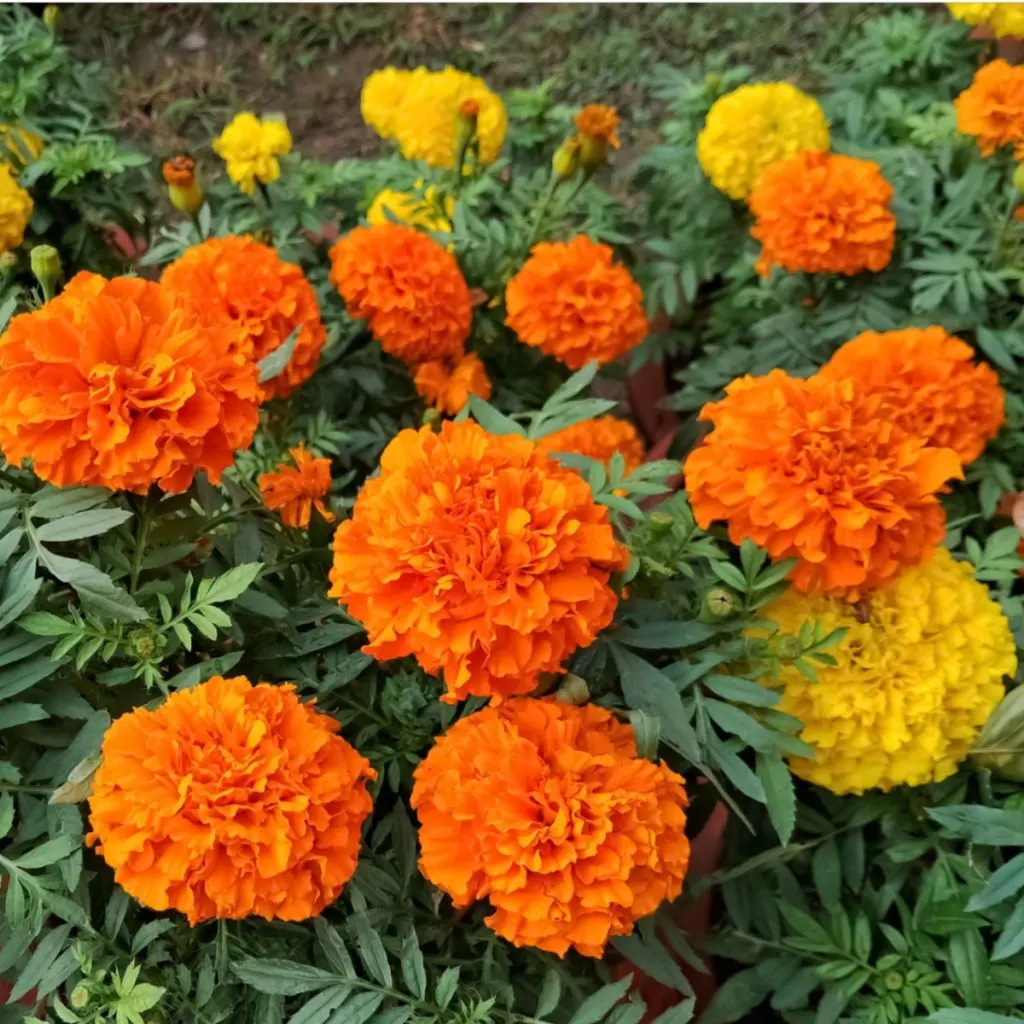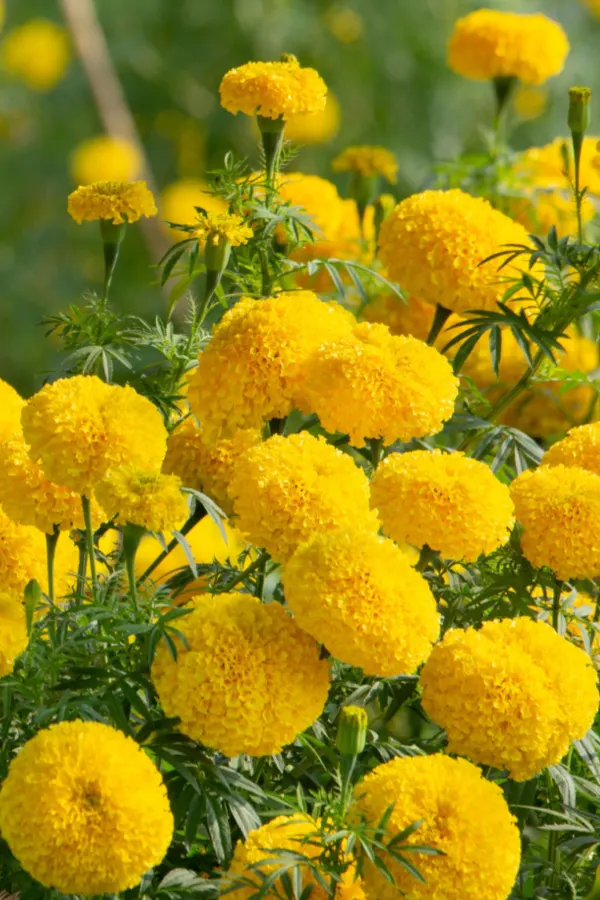Looking for the best way to fertilize your marigolds to keep them healthy and blooming big all summer long?
Marigolds can bring an amazing amount of life and color to flowerbeds, gardens and containers. From petite varieties that nearly cover their entire of canopy of foliage with blooms, to large Pom-Pom and Whopper varieties with flowering heads as big as tennis balls, there is a near endless array of marigolds for any setting.
But to really get the most from your marigold plants you need to supply them with extra energy to bloom big – and even more – keep on blooming big all summer long. And the only way to do that is to fertilize them with just what they need and in just the right amount!

How To Fertilize Marigolds For Bigger & Brighter Blooms!
One of the biggest keys to keeping marigolds flowering strong is to provide them with a steady source of nutrients. Not just when they are young seedlings, but throughout the entire growing season.
The good news is that marigolds have all season lasting power. If given the proper nutrients (and water), they can easily thrive from late spring right up until the first frost. But to keep producing – supplying those nutrients consistently is critical to success.
The blooms sets and flowers on a marigold plant can be quite heavy. And to power all of those blooms and flowers, it requires a lot of energy from the soil. Energy that is quickly depleted if not replenished by fertilizing.
This is true not just for marigolds growing in the limited soil of containers or baskets, but for ones growing in traditional flowerbeds and garden settings too. No matter where they grow, marigolds need a steady source of energy to keep producing more blooms and create more flowers. But to really work well, that power needs to be easy for the plants to absorb and use – and that means using a liquid fertilizer!

Why Using A Liquid Fertilizer Is Better For Marigolds – How To Fertilize Marigolds
When it comes to fertilizing marigolds, liquid fertilizers work better for powering blooms than granular types. Although granular fertilizers provide a slow and steady supply of power to plants, it can often be too slow to promote and replenish strong blooming on a regular basis.
With granular fertilizers, the nutrients require more time to absorb into the plants. Granular fertilizers break down as moisture hits them to leach their power into the roots. This is great for steady, slow growth – but not for powering continuous blooms.
Liquid fertilizers, on the other hand, work quite fast. Because they are already in liquid form, they can absorb into the soil and directly into the roots. Even more, liquid fertilizers absorb into a plant’s stems and foliage as well.
With this dual approach to power, your marigolds get a steady and ready supply of nutrients. And that, of course, is perfect to keep the plant producing new blooms. But, and this is a huge key, only if you are using a liquid fertilizer that is geared toward blooms and not just growth!
Listen Below To Our Podcast On Growing Marigolds – And Their Amazing Benefits!
Selecting The Best Liquid Fertilizers – How To Fertilize Marigolds
Not all fertilizers are the same. Especially when trying to power marigolds to bloom bigger and better. When selecting a liquid fertilizer for blooms, it is far better to choose a fertilizer that has a higher percentage of phosphorous and potassium than nitrogen.
Although nitrogen is an important nutrient that powers strong plant growth, it’s not a main ingredient needed for blooms. In fact, if marigolds get too much nitrogen, all they will do is grow big – but without a lot of blooms!
That is exactly where phosphorous and potassium come into play. Both help greatly in helping plants to create and develop strong blooms. For best results, look for a liquid fertilizer with a considerably higher amount of phosphorous and potassium to nitrogen. Affiliate Link: Farmer’s Secret 2-15-15 Bloom Booster Fertilizer (32oz)
Many times fertilizers with higher phosphorous and potassium amounts will also have “bloom booster” listed on the label. This is exactly the type of fertilizer that will work best! Now on to the second and final secret of fertilizing, how and when to apply.

How & When To Apply – How To Fertilize Marigolds
To get marigolds to flower strong all season long, it all comes down to applying fertilizer on a consistent basis – but at a lighter strength.
Applying too much fertilizer or applying it too often can overpower plants and actually create more foliage and less blooms. Unfortunately, applying too little can lead to weak plants with even weaker blooming.
So how do you apply more often but at a light strength? By simply diluting the liquid fertilizer with more water. Instead of using at full strength, dilute your liquid fertilizer by adding twice the amount of recommended water.
By doing this, instead of feeding every two to three weeks with a strong dose, you can feed marigolds every seven to ten days with a lighter dose. This constant but lower power is perfect for keeping them flowering big. Even more importantly – it also helps to set new blossoms for even more flowers!
Don’t Forget To Deadhead! How To Fertilize Marigolds For Big Blooms
Last but not least, to keep your marigolds blooming strong, be sure to deadhead old blooms on a regular basis. By simply removing the fading blooms from your marigolds once or twice a week, you can double the amount of blooms the plant can produce.
Deadheading stops precious energy from being wasted on old blooms. As long as the old bloom stays on, the plant will keep trying to heal it. But by simply snapping it or cutting it off, that power then gets redirected to producing new buds – and eventually – new flowers.
And don’t be afraid to plant marigolds all over! As amazing as they are for their blooms and beauty, they are also great for protecting other plants from pests. See our article: Why You Should Plant French Marigolds In Your Garden – Protect & Power Your Vegetable Plants!
Here is to powering and energizing your marigolds for bigger and better blooms this year!
This Is My Garden
Follow Our Facebook Page For Great Gardening Tips And Advice! This Is My Garden Facebook Page
This Is My Garden is a garden website created by gardeners, for gardeners. Jim and Mary Competti have been writing gardening, DIY and recipe articles and books and speaking for over 15 years from their 46 acre Ohio farm. They publish three articles every week, 52 weeks a year. Sign up today to follow via email, or follow along!
